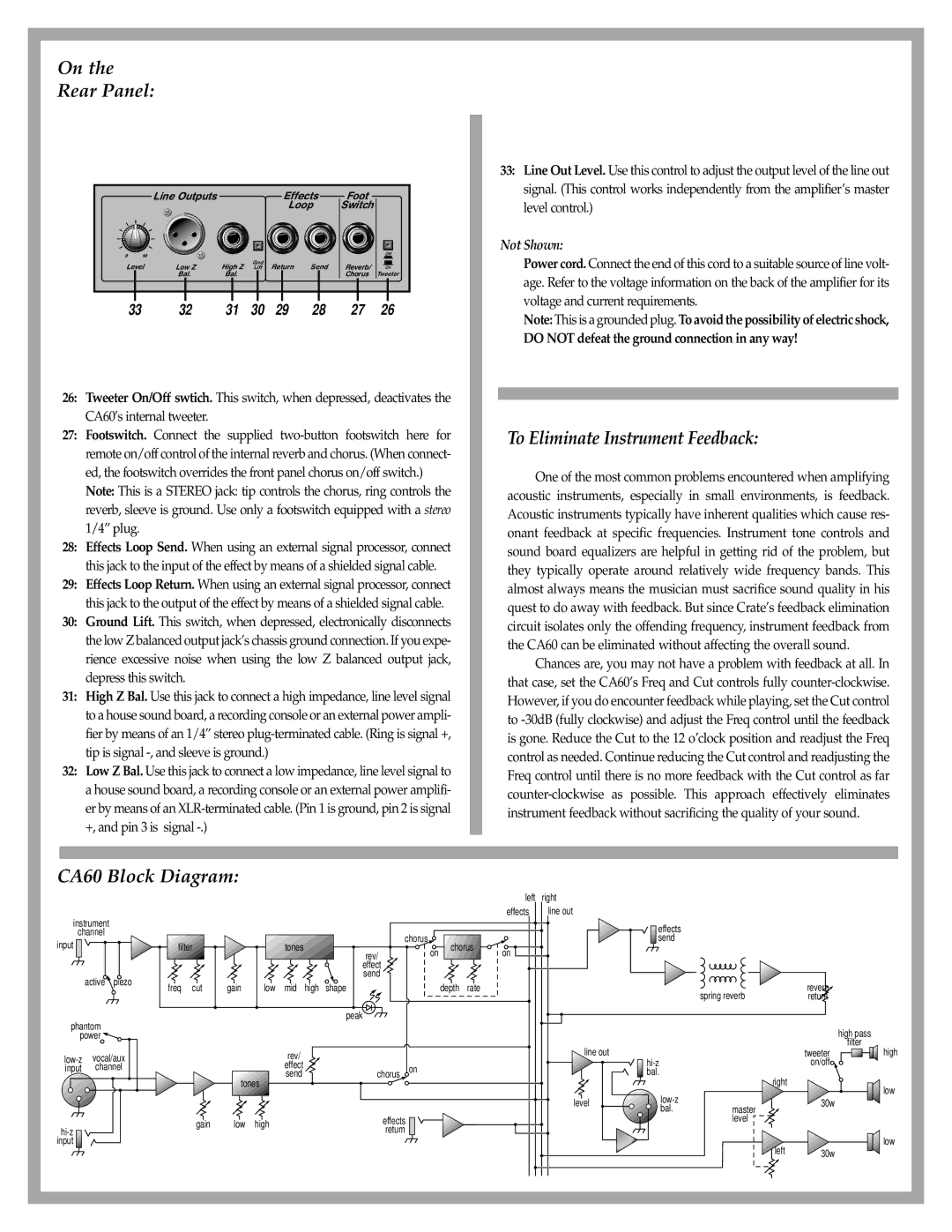
On the
Rear Panel:
|
| Line Outputs |
|
| Effects | Foot |
| |
|
|
|
|
| Loop | Switch |
| |
0 | 10 |
|
|
|
|
|
| Off |
|
|
|
|
|
|
| ||
Level | Low Z | High Z | Gnd | Return | Send | Reverb/ |
| |
Lift | On | |||||||
|
| Bal. | Bal. |
|
|
| Chorus | Tweeter |
| 33 | 32 | 31 | 30 | 29 | 28 | 27 | 26 |
26:Tweeter On/Off swtich. This switch, when depressed, deactivates the CA60’s internal tweeter.
27:Footswitch. Connect the supplied
Note: This is a STEREO jack: tip controls the chorus, ring controls the reverb, sleeve is ground. Use only a footswitch equipped with a stereo 1/4” plug.
28:Effects Loop Send. When using an external signal processor, connect this jack to the input of the effect by means of a shielded signal cable.
29:Effects Loop Return. When using an external signal processor, connect this jack to the output of the effect by means of a shielded signal cable.
30:Ground Lift. This switch, when depressed, electronically disconnects the low Z balanced output jack’s chassis ground connection. If you expe- rience excessive noise when using the low Z balanced output jack, depress this switch.
31:High Z Bal. Use this jack to connect a high impedance, line level signal to a house sound board, a recording console or an external power ampli- fier by means of an 1/4” stereo
32:Low Z Bal. Use this jack to connect a low impedance, line level signal to a house sound board, a recording console or an external power amplifi- er by means of an
33:Line Out Level. Use this control to adjust the output level of the line out signal. (This control works independently from the amplifier’s master level control.)
Not Shown:
Power cord. Connect the end of this cord to a suitable source of line volt- age. Refer to the voltage information on the back of the amplifier for its voltage and current requirements.
Note: This is a grounded plug. To avoid the possibility of electric shock,
DO NOT defeat the ground connection in any way!
To Eliminate Instrument Feedback:
One of the most common problems encountered when amplifying acoustic instruments, especially in small environments, is feedback. Acoustic instruments typically have inherent qualities which cause res- onant feedback at specific frequencies. Instrument tone controls and sound board equalizers are helpful in getting rid of the problem, but they typically operate around relatively wide frequency bands. This almost always means the musician must sacrifice sound quality in his quest to do away with feedback. But since Crate’s feedback elimination circuit isolates only the offending frequency, instrument feedback from the CA60 can be eliminated without affecting the overall sound.
Chances are, you may not have a problem with feedback at all. In that case, set the CA60’s Freq and Cut controls fully
CA60 Block Diagram:
left right
effects line out
instrument
channel
input ![]()
![]()
active ![]() piezo
piezo
phantom power ![]()
filter |
| tones | chorus | chorus | |
| rev/ | on | |||
|
|
|
| ||
|
|
| effect |
|
|
|
|
| send |
|
|
freq cut | gain | low mid high | shape |
| depth rate |
|
|
| peak |
|
|
|
| rev/ |
|
|
|
|
| effect |
| on |
|
|
| send | chorus |
| |
| tones |
|
|
| |
gain | low | high | effects |
|
|
return |
|
| |||
|
|
|
|
| |
on
line out
level
effects send
spring reverb | reverb |
|
return |
| |
|
| high pass |
|
| filter |
| tweeter | high |
on/off |
| |
bal. |
|
|
|
| right | low |
|
| ||
|
| 30w | |
bal. | master |
| |
|
| ||
| level |
|
|
|
| left | low |
|
| 30w | |
|
|
|
